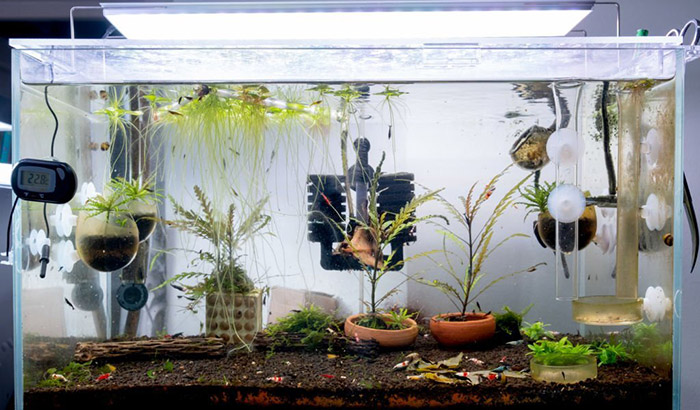Even if you are a beginner in aquarium keeping, you might have already heard of sponge filters. This filter is known for being one of the most simple filters for aquariums. You might wonder how to use a sponge filter; it is elementary. Basically, you will mount it, plug it into a power source and turn it on.
If you are worried about the maintenance and cleaning, there is no need. Sponge Filters are low-cost filters that are easy to use, set up, and clean. Without further ado, let me swim you through the essential information you need to use and maintain a sponge filter.
Contents
Why Do You Need A Sponge Filter
Before we dive deep into the usage of sponge filters, it is better to be informed why you need them. Aquarium water quickly gets filthy without filtration. When wastes and unwanted substances float in the water freely, your fish are more prone to diseases and accidents.
It is imperative to keep the water clean. And while changing water often is an option, it is not the best. Frequent water changing can stress the fish as it will be disturbed and exposed to changing water parameters.
A sponge filter is a device that cleans aquarium water. It uses an air pump that sucks water through a sponge that filters out the debris and other tiny substances. It ideally sucks in the water gently and causes less noise than other filters.
How to Set Up a Sponge Filter
Setting up a sponge filter is generally easy. Although it changes according to the brand and model, the usual steps are:
Step 1:
A sponge filter should include a lift tube, airline tubes, an air pump, a weighted base, a check valve, a sponge, and an air stone. Air stones are optional; they create smaller bubbles for better oxygen diffusion and reduce noise. Make sure you have all parts in perfect condition. One part less will render your sponge filter useless.
The sponge should have a hollow tube inside called a strainer. Aside from the strainer, if the sponge has plastic or paper inside, make sure to remove it.
Step 2:
Detach the bullseye from the strainer; it is found at one end of the strainer. Insert the air stone to the bottom. Connect the air stone to the bullseye using the airline tube. Then attach the bullseye back to the strainer and insert the strainer back into the sponge.
Step 3:
A sponge filter works best at the bottom of the tank. Attach the strainer to the weighted base to keep it at the bottom. It’s time to attach the lift tube securely to the bullseye. Then, put the sponge filter into the tank under the water. Squeeze the air out of the sponge filter, so it sinks to the bottom quicker.
Step 4:
Connect the check valve between the airline tubing and the air pump with the colored end facing the air pump. The check valve prevents water from flowing back into the air pump. Install the other end of the airline tube to the sponge filter. Lastly, plug in the sponge filter to a power source.
The best course of action is to search how to set up a sponge filter in the packaging.
How to Clean Aquarium Sponge Filter
Probably the filthiest part of an aquarium is the filter. While it keeps the aquarium water clean, it sucks all the dirt. You will quickly know when it is time to clean the filter as you will notice dirt and debris on the sponge’s surface.
But how to clean the aquarium sponge filter efficiently? First, you need to turn it off and disconnect the airline tube from the sponge filter. Next, detach the bullseye from the strainer inside the sponge, and with a plastic bag around your hand, scoop out the sponge filter.
Squeeze out the water into a drain or a bucket. Repeatedly wash the sponge and wring out the water until you see clean water coming out of it. Keep the plastic bag around your hand while doing this process.
Finally, you can assemble the aquarium sponge filter back together and submerge it into the tank. Soon enough, you will notice the tank water getting clean.
Can I Use Regular Sponge for Aquarium Filter
So what can you use as a backup sponge if, for some reason, the sponge in your aquarium filter tears or gets too dirty? “Can I use a regular sponge for aquarium filter?” you might ask. Well, yes, unless the packaging says otherwise.
If you are going to use a regular kitchen sponge, make sure it does not have cleaning chemicals or dyes that could harm your fish. Look out for moisturizing agents and magnesium chloride in your sponge. These chemicals are harmful to the health of your fish.
A regular sponge is cheaper than an actual aquarium sponge filter, and it does not work as effectively. The downside of using a regular sponge is that it is not as porous as an aquarium sponge. It limits the water that gets sucked in and cannot properly clean it.
Although you can use a regular sponge for aquarium filters, the best for your fish is still a sponge made for aquarium sponge filters.
Conclusion
Finally, you now know how to use a sponge filter. The well-known filter will work great on both small and large aquariums. One of the best parts is that it does not require much maintenance work, and it cleans effectively. Are you convinced that it is a good choice for a filter for your tank?

